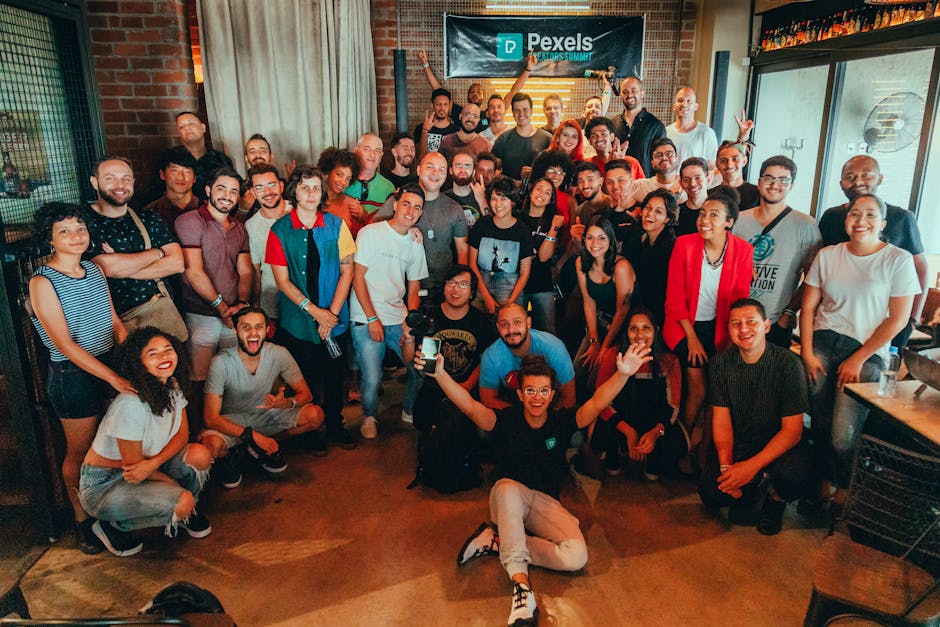The Power of Challenges: Understanding Core Dynamics
Online challenges have emerged as a highly effective strategic tool for engagement, learning, and business growth. Their success stems from a deep understanding of human psychology and a structured approach to participation. Unlike passive content consumption, challenges demand active involvement, fostering a sense of purpose and achievement among participants. This active engagement is critical in today’s attention economy, where consumers are constantly bombarded with information and distractions.
The fundamental appeal of challenges lies in their ability to provide clear boundaries and a defined journey. Participants know precisely what is expected of them, the duration of the challenge, and the desired outcome. This clarity reduces cognitive load and encourages commitment. From a strategic perspective, challenges work because they convert passive audiences into active participants, a crucial shift for any online community or business aiming for sustained interaction.
Moreover, challenges leverage intrinsic human desires for progress, mastery, and social connection. When designed thoughtfully, they tap into these motivations, creating a compelling experience that transcends simple information delivery. The structured nature of challenges, often with daily tasks or weekly milestones, provides a consistent rhythm that helps participants build momentum and integrate new behaviors or knowledge effectively. This methodical approach is far more impactful than sporadic engagement.
The strategic framework behind high-performance online challenges is not accidental; it is built upon principles of gamification, community psychology, and effective instructional design. Businesses and educators increasingly recognize that challenges offer a dynamic alternative to traditional methods, yielding higher completion rates and more profound transformations. This makes them an invaluable asset for anyone looking to foster deep engagement and drive specific outcomes.
Understanding these core dynamics is the first step in harnessing the power of challenges. They are not merely marketing gimmicks but sophisticated engagement engines that, when properly configured, can deliver significant value to both the organizer and the participant. The structured progression, combined with psychological motivators, creates an environment where individuals are more likely to commit, persevere, and achieve their goals, ultimately benefiting the challenge host.
What Makes Challenges So Effective?
- Defined Goals and Structure: Challenges provide clear objectives and a step-by-step path, making success feel attainable. This contrasts sharply with open-ended learning or growth paths that can feel overwhelming.
- Time-Bound Urgency: The limited duration creates a sense of urgency and encourages immediate action, combating procrastination. This “fear of missing out” (FOMO) effect is a powerful motivator, as noted by sources like Bridgetbrands.
- Community and Accountability: Participants often engage in a shared experience, fostering peer support and a sense of collective accountability. This social element significantly boosts motivation and retention.
- Achievable Milestones: Breaking down larger goals into smaller, manageable daily or weekly tasks makes the overall objective less daunting and provides frequent opportunities for success, reinforcing positive behavior.
- Psychological Rewards: The sense of accomplishment from completing tasks and progressing through the challenge provides intrinsic rewards that drive continued participation.
Psychological Drivers of Engagement in Challenges
The effectiveness of online challenges is deeply rooted in fundamental psychological principles that motivate human behavior. By understanding these drivers, creators can design challenges that resonate profoundly with participants, leading to higher engagement and better outcomes. These principles move beyond superficial interaction, tapping into deeper desires for growth, connection, and achievement.
One primary driver is the human need for progress and mastery. Challenges inherently offer a path to improvement, whether it’s learning a new skill, adopting a healthier habit, or achieving a specific goal. Each completed task or milestone provides a sense of accomplishment, reinforcing the participant’s belief in their ability to succeed. This positive feedback loop is crucial for sustained motivation and commitment throughout the challenge duration.
Another powerful psychological element is social connection and belonging. Many challenges are designed to be communal experiences, where participants share their progress, struggles, and successes with a group. This fosters a sense of community, mutual support, and accountability. The desire to not let down one’s peers, or to celebrate victories together, significantly amplifies engagement. Gamification Essentials highlights how challenges are a community’s secret weapon for engagement.
The concept of “scarcity” or “urgency” also plays a significant role. Challenges are typically time-bound, creating a limited window for participation and completion. This temporal constraint triggers the “fear of missing out” (FOMO), prompting individuals to act rather than procrastinate. The finite nature of a challenge makes the commitment feel less overwhelming than an open-ended program, making it easier for potential participants to say “yes.”
Finally, challenges often tap into the desire for novelty and a break from routine. They offer a structured way to introduce new activities or learning into one’s life, providing a fresh perspective and an opportunity for personal transformation. This psychological appeal makes challenges a compelling proposition for individuals seeking change or a new direction, whether in their personal or professional lives.
Key Psychological Motivators for Challenge Participation
- Autonomy: While structured, challenges often allow participants some choice in how they approach tasks, fostering a sense of control over their journey.
- Competence: The design of challenges to include achievable steps builds a sense of competence as participants successfully complete tasks.
- Relatedness: The community aspect satisfies the innate human need for connection and belonging, turning individual efforts into a shared journey.
- Goal-Setting Theory: Challenges provide clear, specific, and often measurable goals, which are known to be more motivating than vague aspirations.
- Self-Efficacy: Successfully navigating a challenge boosts an individual’s belief in their own capabilities, encouraging them to tackle future challenges.

Designing Effective Challenge Mechanics
The architecture of an online challenge is paramount to its success. Effective challenge mechanics ensure that participants remain engaged, motivated, and ultimately achieve the desired outcomes. This involves careful planning of the challenge structure, task design, reward systems, and communication strategies. A well-designed challenge feels intuitive and rewarding, not burdensome.
A critical mechanic is the clear definition of the challenge’s scope and duration. Participants need to know exactly what they are signing up for. Whether it’s a 5-day sprint or a 30-day transformation, setting expectations upfront is vital. The duration should be long enough to facilitate meaningful change but short enough to maintain momentum and prevent burnout. For instance, understanding how to create a successful online challenge often involves careful consideration of its length.
Task design is another cornerstone. Tasks should be progressive, building upon previous learning or actions, and incrementally increasing in difficulty. They must be actionable, specific, and relevant to the overarching goal of the challenge. Providing clear instructions, examples, and resources for each task minimizes confusion and maximizes participation. The goal is to make each step feel achievable, fostering a sense of continuous progress.
Incorporating elements of gamification can significantly boost engagement. This includes points, badges, leaderboards, and levels. While not all challenges require overt gamification, the underlying principles—such as immediate feedback, visible progress, and recognition for effort—are universally beneficial. These elements tap into the competitive spirit and the desire for social validation, making the journey more enjoyable and motivating.
Finally, robust communication and support mechanisms are essential. Regular check-ins, reminders, and opportunities for participants to ask questions and share their experiences are crucial. This can be facilitated through dedicated online communities, live Q&A sessions, or email sequences. Effective communication reinforces the sense of community and ensures participants feel supported throughout their journey, addressing potential roadblocks before they lead to drop-off.
Core Elements of High-Performance Challenge Design
- Clear Objective: Define a single, compelling goal that participants can strive for. Example: “Write 500 words daily for 7 days” or “Complete 3 workouts per week for 4 weeks.”
- Structured Progression: Break the main objective into daily or weekly micro-tasks that build logically. Each task should be a stepping stone to the next.
- Actionable Tasks: Ensure each task is specific, measurable, achievable, relevant, and time-bound (SMART). Avoid vague instructions.
- Feedback Loops: Provide opportunities for participants to track their progress, receive feedback, and celebrate small wins. This could be a checklist, a progress bar, or peer feedback.
- Support System: Establish a community forum, group chat, or dedicated support channel where participants can interact, ask questions, and receive encouragement.
Examples of Effective Challenge Mechanics
- Daily Prompts: A writing challenge that provides a new prompt each day to inspire content creation.
- Skill-Building Sprints: A coding challenge where participants learn a new function or concept each day and apply it in a small project.
- Habit Trackers: A wellness challenge that encourages daily logging of water intake, steps, or meditation minutes.
- Creative Showcases: A photography challenge where participants share a photo based on a theme daily, receiving peer feedback.
Strategic Business Objectives for Online Challenges
Online challenges are not merely engagement tools; they are powerful strategic instruments that can drive significant business outcomes. Businesses leverage challenges for a variety of purposes, ranging from lead generation and brand awareness to product validation and customer retention. Aligning the challenge design with specific business objectives is critical for maximizing return on investment.
One primary objective is lead generation. Free challenges, in particular, serve as excellent top-of-funnel magnets, attracting a broad audience interested in a specific topic or outcome. By requiring an email signup to participate, businesses can rapidly grow their mailing lists with highly qualified leads. These leads can then be nurtured through subsequent marketing efforts, converting them into paying customers.
Another key objective is building brand authority and thought leadership. By offering valuable content and guidance through a challenge, businesses position themselves as experts in their field. This builds trust and credibility with potential customers, making them more likely to choose that brand when they are ready to make a purchase. Challenges demonstrate expertise in a practical, results-oriented way.
Challenges can also be strategically employed for product or service validation and improvement. By observing how participants interact with challenge content, tools, or methodologies, businesses can gather invaluable feedback. This direct user experience data can inform product development, refine service offerings, and identify new market opportunities. It’s a real-world testing ground that provides actionable insights.
Finally, challenges are potent tools for customer retention and fostering loyalty. For existing customers, a challenge can deepen their engagement with a brand, provide ongoing value, and reinforce their purchasing decision. This can lead to increased lifetime value, repeat purchases, and powerful word-of-mouth referrals. The shared experience within a challenge strengthens the bond between customer and brand.
Common Business Objectives Achieved Through Challenges
- Lead Generation: Attracting new prospects and building an email list. According to Salesforce marketing statistics, effective lead generation remains a top priority for businesses.
- Brand Awareness: Increasing visibility and recognition for a brand or its offerings.
- Audience Engagement: Fostering deeper interaction and connection with a target demographic.
- Product/Service Launch: Creating buzz and demonstrating the value of a new offering.
- Customer Retention: Providing ongoing value to existing clients, reducing churn, and increasing loyalty.
- Market Research: Gathering insights into customer needs, pain points, and preferences.
- Community Building: Cultivating a loyal and interactive community around a brand or topic.

Free Versus Paid Challenges: A Strategic Comparison
The decision to offer a free or paid online challenge is a critical strategic choice that impacts audience reach, commitment levels, and revenue generation. Both models have distinct advantages and disadvantages, and the optimal choice depends heavily on the specific business objectives and target audience. Understanding the nuances of each approach is essential for effective challenge deployment.
Free challenges excel at broad audience acquisition and lead generation. They lower the barrier to entry, making it easy for a large number of people to participate. This is ideal for building an email list, increasing brand awareness, and introducing potential customers to a brand’s value proposition. The primary goal of a free challenge is often to convert participants into paying customers for higher-tier products or services, as highlighted by BDOW stories on creating free challenges for traffic.
However, free challenges typically come with lower commitment rates. Participants, having invested no monetary value, may be more likely to drop off if they encounter difficulties or lose interest. The perceived value can also be lower, as people often associate price with quality. Despite this, a well-designed free challenge can still deliver significant value and build strong goodwill, setting the stage for future conversions.
Paid challenges, conversely, attract a more committed and invested audience. The monetary investment acts as a filter, ensuring that only individuals serious about achieving the challenge’s outcome participate. This higher level of commitment often translates into significantly better engagement rates, completion rates, and ultimately, more profound transformations for participants. The perceived value of a paid challenge is also inherently higher.
While paid challenges generate direct revenue, their audience reach is typically smaller than free challenges. They require a stronger value proposition and more robust marketing efforts to convince participants to invest. However, the quality of engagement and the potential for deeper impact often outweigh the smaller numbers. The discussion around the effectiveness of paid challenges versus online courses often emphasizes this commitment factor.
Comparative Analysis: Free vs. Paid Challenges
| Feature | Free Challenges | Paid Challenges |
|---|---|---|
| Primary Objective | Lead Generation, Brand Awareness, Audience Building | Revenue Generation, Deep Engagement, High Transformation |
| Audience Size | Larger, broader reach | Smaller, more targeted |
| Commitment Level | Lower (higher drop-off rate) | Higher (monetary investment) |
| Perceived Value | Can be lower, but builds goodwill | Higher, associated with quality |
| Monetization | Indirect (upsell to other products/services) | Direct (challenge fee) |
| Marketing Effort | Focus on volume, ease of entry | Focus on value proposition, transformation |
When to Choose Each Model
- Choose Free Challenges When:
- You are building an audience from scratch.
- Your primary goal is lead generation and email list growth.
- You want to introduce a new concept or methodology to a wide audience.
- You aim to create buzz and social proof for a larger offering.
- Choose Paid Challenges When:
- You have an established audience and want to deepen engagement.
- Your goal is direct revenue generation from the challenge itself.
- You are offering a high-value transformation that requires significant commitment.
- You want to filter for highly motivated participants.
Community Building Through Shared Experiences
One of the most profound benefits of online challenges is their unparalleled ability to foster strong, vibrant communities. The shared experience of working towards a common goal creates a powerful bond among participants, transforming individual endeavors into collective journeys. This community aspect is a critical differentiator that elevates challenges beyond mere content delivery.
Challenges naturally encourage interaction and mutual support. As participants navigate tasks, overcome obstacles, and celebrate successes, they often turn to their peers for encouragement, advice, and accountability. This organic interaction builds relationships, creating a network of individuals who are invested in each other’s progress. This dynamic is a stark contrast to isolated learning experiences, where motivation can wane without external encouragement.
The structure of a challenge provides a ready-made context for communication. Daily check-ins, progress updates, and problem-solving discussions become natural points of connection. Challenge hosts can further facilitate this by creating dedicated forums, social media groups, or live Q&A sessions, providing platforms for participants to engage. This structured interaction helps overcome the initial awkwardness of online networking, making it easier for individuals to connect authentically.
Moreover, shared struggle and triumph are powerful catalysts for bonding. When participants collectively face a difficult task and then celebrate its completion, the shared emotional experience strengthens their connection. This communal aspect not only enhances the individual’s experience but also creates a loyal and engaged community around the challenge host’s brand or mission. Rachel Business Coach emphasizes creating engaging challenges to keep communities hooked.
Ultimately, the community built through challenges can become a self-sustaining ecosystem. Participants who have successfully completed a challenge often become advocates, mentors, or even repeat customers for future offerings. This creates a virtuous cycle where the community itself becomes a powerful asset, driving future engagement and growth. The investment in fostering this shared experience yields long-term dividends.
Strategies for Fostering Community in Challenges
- Dedicated Communication Channels: Utilize platforms like Facebook Groups, Slack channels, or a dedicated forum within your challenge platform for interaction.
- Facilitated Introductions: Encourage participants to introduce themselves at the beginning of the challenge, sharing their goals and expectations.
- Peer Accountability Partners: Suggest or facilitate pairing participants for mutual support and accountability.
- Regular Live Sessions: Host live Q&A sessions, workshops, or virtual meetups to create real-time connection and address common issues.
- Celebrate Milestones: Publicly acknowledge and celebrate individual and group achievements throughout the challenge to reinforce positive behavior and community spirit.
- User-Generated Content: Encourage participants to share their progress, insights, and creations, fostering a sense of ownership and contribution.

Measuring Success and Iterating Challenge Design
To ensure online challenges consistently deliver high performance, it is crucial to establish clear metrics for success and adopt an iterative approach to design. Without proper measurement, it’s impossible to identify what works, what doesn’t, and where improvements can be made. This data-driven approach transforms challenges from one-off events into continuously optimized engagement engines.
Key performance indicators (KPIs) for challenges typically include enrollment rates, active participation rates, completion rates, and post-challenge conversion rates. Enrollment rates indicate the effectiveness of marketing efforts, while active participation and completion rates reflect the challenge’s design and engagement mechanics. Conversion rates, such as sales of a subsequent product, measure the challenge’s impact on business objectives.
Beyond quantitative metrics, qualitative feedback is equally important. Surveys, testimonials, and direct interactions with participants can provide invaluable insights into their experience, pain points, and areas of delight. This feedback helps uncover the “why” behind the numbers, offering a deeper understanding of participant motivations and challenge effectiveness. It can reveal aspects that quantitative data alone might miss.
Once data and feedback are collected, the next step is iteration. This involves analyzing the insights, identifying areas for improvement, and implementing changes in subsequent challenge iterations. This continuous improvement cycle ensures that each new challenge is more refined, more engaging, and more effective than the last. It’s a process of learning, adapting, and optimizing based on real-world performance.
For example, if a challenge has high enrollment but low completion, it might indicate that the tasks are too difficult, the support is inadequate, or the initial expectations were misaligned. Conversely, a high completion rate with low post-challenge conversions might suggest a need to refine the call to action or the value proposition of the subsequent offering. This iterative process is fundamental to achieving sustained high performance.
Key Metrics for Challenge Success
- Enrollment Rate: Number of sign-ups divided by total reach or impressions.
- Active Participation Rate: Percentage of enrolled participants actively engaging with daily tasks or community discussions.
- Completion Rate: Percentage of participants who successfully finish all challenge requirements.
- Engagement Rate: Metrics like comments, likes, shares within the challenge community.
- Conversion Rate: Percentage of participants who take a desired next step (e.g., purchase a product, sign up for a course).
- Feedback Scores: Participant satisfaction ratings from surveys or polls.
- Testimonials & Case Studies: Qualitative evidence of transformation and success.
Iterative Improvement Cycle for Challenges
- Plan: Define objectives, design mechanics, set KPIs.
- Launch: Execute the challenge, monitor initial engagement.
- Measure: Collect quantitative data (enrollment, completion, conversion) and qualitative feedback (surveys, testimonials).
- Analyze: Interpret data, identify strengths, weaknesses, and areas for improvement.
- Adjust: Implement changes to mechanics, content, marketing, or follow-up strategy for the next iteration.
Overcoming Common Challenge Pitfalls
While online challenges offer immense potential, they are not immune to common pitfalls that can derail their effectiveness. Recognizing and proactively addressing these challenges is crucial for ensuring a high-performance outcome. Strategic foresight and careful planning can mitigate many of these issues, transforming potential failures into learning opportunities.
One frequent pitfall is a lack of clarity in the challenge’s objective or tasks. If participants are unsure what they are supposed to do or why, motivation quickly wanes. This leads to confusion, frustration, and ultimately, high drop-off rates. The solution lies in meticulous planning, ensuring that every task is clearly articulated, actionable, and directly contributes to the overall challenge goal.
Another common issue is insufficient support or community engagement. Participants in challenges often need encouragement, answers to questions, and a sense of belonging. If the host fails to provide adequate support or foster a vibrant community, individuals can feel isolated and lose motivation. Proactive moderation, regular check-ins, and dedicated support channels are essential to keep the community thriving.
Overwhelm and burnout are also significant risks. Challenges that demand too much time, present overly difficult tasks, or lack sufficient breaks can exhaust participants. The key is to strike a balance between pushing participants towards growth and ensuring the challenge remains sustainable and enjoyable. Incremental difficulty and well-paced content delivery are vital for long-term engagement.
Finally, a misalignment between the challenge’s value proposition and the target audience’s needs can lead to poor enrollment or engagement. If the challenge doesn’t genuinely address a pain point or desire of the audience, it will fail to attract or retain participants. Thorough audience research and a compelling value proposition are foundational to avoiding this pitfall. Understanding comparing online courses and challenges can help in tailoring the right offering.
Strategies to Avoid Common Challenge Pitfalls
- Pre-Launch Testing: Pilot your challenge with a small group to identify confusing instructions or overly difficult tasks before a full launch.
- Clear Communication: Over-communicate expectations, daily tasks, and support options. Use multiple channels (email, community platform) for reminders.
- Build in Flexibility: While structured, allow for some flexibility or grace periods for task completion to accommodate real-life demands.
- Proactive Support: Have a dedicated team or individual to answer questions promptly and engage with participants in the community.
- Celebrate Small Wins: Regularly acknowledge and celebrate progress, no matter how small, to maintain motivation and combat discouragement.
- Feedback Mechanisms: Implement quick polls or surveys throughout the challenge to gauge participant sentiment and make real-time adjustments if needed.

Integrating Challenges with Broader Strategies
For online challenges to achieve their full potential, they must be seamlessly integrated into a broader marketing and business strategy. Challenges should not operate in isolation but rather serve as a powerful component within a larger ecosystem of content, products, and community initiatives. This strategic alignment ensures that challenges contribute meaningfully to overarching organizational goals.
One key integration point is the content marketing funnel. Challenges can serve as a compelling top-of-funnel offering, attracting new leads and introducing them to a brand’s expertise. They can also function as middle-of-funnel content, nurturing existing leads with deeper engagement and demonstrating value. By strategically placing challenges within the customer journey, businesses can guide prospects more effectively towards conversion.
Challenges also integrate well with product launches and educational programs. A challenge can act as a pre-launch buzz builder, generating excitement and demand for an upcoming product. Alternatively, it can serve as a foundational module for a larger online course, preparing participants with essential skills or mindsets. This creates a natural progression from a short, focused challenge to a more comprehensive offering.
Furthermore, challenges can enhance customer retention and loyalty programs. For existing customers, a challenge can provide ongoing value, encouraging continued engagement with the brand and its community. This can take the form of advanced challenges, exclusive content, or peer-to-peer support groups, all designed to deepen the customer relationship and increase lifetime value. This is particularly relevant for platforms like Communipass challenges which aim to foster ongoing engagement.
Finally, data derived from challenges can inform broader strategic decisions. Insights into participant behavior, common struggles, and successful outcomes can guide future content creation, product development, and marketing messaging. This feedback loop ensures that challenges are not just standalone events but integral components of a dynamic and responsive business strategy, continuously driving improvement across the organization.
Strategic Integration Points for Online Challenges
- Content Marketing Funnel:
- Top-of-Funnel: Free challenges for lead generation and brand awareness.
- Middle-of-Funnel: Paid challenges or more in-depth free challenges to nurture leads and build trust.
- Bottom-of-Funnel: Challenges as a pre-cursor or bonus to a core product/service.
- Product/Service Ecosystem:
- Launch Support: Generate excitement and provide a taste of a new product’s benefits.
- Onboarding: Guide new users through initial steps of a complex product.
- Upsell/Cross-sell: Introduce complementary products or services to engaged challenge participants.
- Community & Loyalty Programs:
- Retention: Offer exclusive challenges to existing members to increase engagement and loyalty.
- Advocacy: Empower challenge completers to become brand ambassadors or mentors.
- Market Research & Development:
- Feedback Loop: Use challenge data to inform product improvements and new offerings.
- Trend Identification: Observe participant needs and behaviors to spot emerging market trends.
Future Trends in Online Challenges
The landscape of online challenges is continuously evolving, driven by technological advancements, changing consumer expectations, and innovative approaches to engagement. Staying abreast of these future trends is essential for creators and businesses looking to design high-performance challenges that remain relevant and impactful. The future promises more personalized, interactive, and data-rich challenge experiences.
One significant trend is the increasing integration of artificial intelligence (AI) and machine learning. AI can personalize challenge experiences by adapting tasks, feedback, and support based on individual participant progress and preferences. This level of customization can dramatically increase engagement and success rates, making challenges more effective for a diverse audience. Imagine an AI coach within a challenge, tailoring the journey in real-time.
Another emerging trend is the rise of micro-challenges and bite-sized learning. As attention spans continue to shrink, shorter, more focused challenges that deliver quick wins are gaining traction. These micro-challenges can be easily integrated into daily routines, making participation less daunting and more sustainable. They cater to the demand for immediate gratification and continuous, incremental progress.
The emphasis on immersive and interactive experiences will also grow. This includes leveraging virtual reality (VR) or augmented reality (AR) for more engaging tasks, interactive simulations, and gamified environments. Challenges will move beyond simple text and video, offering richer, multi-sensory experiences that deepen participant immersion and learning. This aligns with broader digital media trends, as noted by Deloitte Insights.
Furthermore, expect to see a greater focus on data privacy and ethical AI in challenge design. As personalization becomes more sophisticated, ensuring transparency in data usage and protecting participant information will be paramount. Challenges will need to build trust through ethical practices, balancing personalization with privacy concerns. This will be a critical factor for sustained user adoption and regulatory compliance.
Anticipated Trends Shaping Online Challenges
- Hyper-Personalization: AI-driven adaptation of challenge content, pacing, and feedback to individual needs and progress.
- Micro-Learning & Gamification: Shorter, highly gamified challenges focused on specific skills or habits, designed for quick wins and sustained engagement.
- Immersive Technologies: Integration of VR/AR for more interactive and engaging challenge environments, particularly in skill-based or experiential challenges.
- Community-Led Challenges: Greater emphasis on peer-to-peer learning, user-generated content, and participant-driven initiatives within challenges.
- Ethical AI & Data Privacy: Transparent use of data for personalization, with strong safeguards for participant privacy and ethical considerations in AI design.
- Hybrid Models: Blending online challenge components with offline meetups or physical activities for a more holistic experience.
Case Studies in Challenge Effectiveness
While specific named company case studies are not available in the provided research, the principles of challenges have been successfully applied across various domains, demonstrating their broad effectiveness. These examples illustrate how the strategic framework behind challenges translates into tangible results, from fitness and personal development to business growth and skill acquisition.
Consider the widespread success of fitness challenges. Programs like “30-Day Yoga Challenges” or “7-Day Detox Sprints” leverage the time-bound nature and clear objectives to motivate participants. They often include daily workout videos, meal plans, and a supportive online community. The psychological drivers of progress and mastery are evident as participants track their physical changes and celebrate milestones, leading to improved health outcomes and strong brand loyalty for fitness coaches and platforms, as discussed by LandonP.
In the realm of personal development, “habit-building challenges” have proven highly effective. A “21-Day Meditation Challenge” or a “Gratitude Journaling Challenge” provides a structured framework for individuals to adopt new positive habits. The daily commitment, coupled with peer support, helps overcome the initial resistance to change. Participants often report increased well-being and sustained habit formation long after the challenge concludes, showcasing the power of consistent action within a supportive structure.
For businesses, “content creation challenges” are a prime example of lead generation and skill development. A “5-Day Blog Post Challenge” or a “Video Content Creation Sprint” encourages participants to produce specific outputs. These challenges not only help individuals develop valuable skills but also demonstrate the host’s expertise, often leading to sign-ups for more advanced courses or services. The tangible output serves as both a personal achievement and a marketing asset for the participant.
Finally, coding or technical skill challenges illustrate the power of challenges in education. Platforms hosting “30-Day Python Challenges” or “Web Development Sprints” provide daily coding exercises and projects. The structured learning path, immediate feedback, and competitive elements (leaderboards) motivate participants to acquire complex skills rapidly. These challenges often culminate in a portfolio-worthy project, demonstrating real-world applicability and driving career advancement for participants.
Illustrative Examples of Successful Challenge Applications
- Fitness & Wellness:
- Example: “30-Day Plank Challenge” – Daily progression, clear physical goal, community support.
- Outcome: Improved core strength, habit formation, increased engagement with fitness brand.
- Personal Development:
- Example: “7-Day Digital Detox Challenge” – Daily tasks to reduce screen time, focus on mindfulness.
- Outcome: Reduced digital overwhelm, increased focus, adoption of healthier tech habits.
- Business & Marketing:
- Example: “10-Day Email List Building Challenge” – Daily actionable steps to grow an email subscriber base.
- Outcome: Increased lead generation, practical skill acquisition for participants, brand authority for host.
- Creative Arts:
- Example: “Inktober” (drawing challenge) – Daily prompts for artists to create and share ink drawings.
- Outcome: Skill improvement, community engagement, portfolio building, global recognition for the challenge.

Implementation Guide for High-Performance Challenges
Launching a high-performance online challenge requires a systematic approach, moving from conceptualization to execution and post-challenge analysis. This implementation guide outlines the critical steps involved in designing, promoting, running, and optimizing challenges to ensure maximum impact and participant satisfaction. A structured process is key to converting strategic intent into tangible results.
The first phase involves meticulous planning. This includes defining the challenge’s core objective, identifying the target audience, and outlining the specific transformation or outcome participants will achieve. It’s crucial to research your audience’s pain points and desires to ensure the challenge offers a compelling solution. This foundational work dictates the entire design and marketing strategy.
Next is the content and mechanics design. Break down the overarching goal into daily or weekly actionable tasks. Develop clear instructions, provide necessary resources (templates, videos, guides), and decide on any gamification elements. Plan for community interaction, support mechanisms, and how progress will be tracked. The journey should be logical, progressive, and engaging from start to finish.
The pre-launch and launch phases focus on promotion and enrollment. Craft compelling marketing messages that highlight the challenge’s benefits and urgency. Utilize various channels—social media, email marketing, partnerships—to reach your target audience. Ensure the registration process is seamless and that participants receive clear onboarding instructions as soon as they sign up. This initial experience sets the tone for the entire challenge.
During the challenge, active facilitation and support are paramount. Engage with participants in the community, answer questions, provide encouragement, and celebrate milestones. Monitor progress and address any technical or motivational issues promptly. Your presence and responsiveness are critical for maintaining momentum and fostering a supportive environment. This is where the human element truly shines.
Finally, post-challenge analysis and follow-up are essential for long-term success. Collect feedback, analyze performance metrics, and identify areas for improvement. Plan your post-challenge strategy, whether it’s an upsell to a paid product, an invitation to a deeper community, or a survey for future challenge ideas. This iterative process ensures continuous optimization and maximizes the value derived from each challenge.
Step-by-Step Implementation for Online Challenges
- Phase 1: Strategic Planning
- Define clear challenge objective and desired outcome.
- Identify target audience and their specific needs/pain points.
- Determine challenge duration (e.g., 5-day, 7-day, 30-day).
- Decide on free vs. paid model and pricing (if applicable).
- Outline the core transformation or skill acquisition.
- Phase 2: Content & Mechanics Design
- Break down the main goal into daily/weekly actionable tasks.
- Create all necessary content: instructions, videos, worksheets, templates.
- Design community interaction points and support mechanisms.
- Integrate gamification elements (optional: points, badges, leaderboards).
- Plan for progress tracking and completion recognition.
- Phase 3: Pre-Launch & Promotion
- Develop compelling marketing copy and visuals.
- Choose promotion channels (social media, email, ads, partnerships).
- Set up registration page and email automation sequence.
- Build anticipation and urgency before launch.
- Phase 4: Challenge Execution & Facilitation
- Launch the challenge and onboard participants.
- Actively engage in the community, answer questions, provide support.
- Send daily reminders and motivational messages.
- Celebrate progress and milestones.
- Address any technical or participant issues promptly.
- Phase 5: Post-Challenge Analysis & Follow-up
- Collect feedback via surveys and testimonials.
- Analyze key metrics: enrollment, participation, completion, conversion rates.
- Identify strengths, weaknesses, and areas for improvement.
- Implement a clear post-challenge offer or next step for participants.
- Plan for the next iteration of the challenge based on learnings.
Frequently Asked Questions (FAQ)
How do I choose the right topic for my online challenge?
To choose the right topic, identify a specific pain point or desired outcome for your target audience that you can help them achieve within a short, defined period. It should be a clear, actionable goal that resonates deeply with their needs and offers a tangible transformation.
Consider these factors:
- Audience Needs: What problems do your potential participants want to solve?
- Your Expertise: What unique knowledge or skills can you offer to guide them?
- Achievable Outcome: Can the goal be realistically achieved within the challenge timeframe?
- Market Demand: Is there a genuine interest or existing conversation around this topic?
What are the typical durations for effective online challenges?
Effective online challenges typically range from 5 to 30 days. Shorter challenges (5-7 days) are excellent for quick wins and lead generation, while longer ones (14-30 days) allow for deeper transformation and habit formation, fostering greater commitment.
Common durations include:
- 5-Day Challenges: Ideal for introducing a concept or achieving a small, immediate goal.
- 7-Day Challenges: Popular for habit-building or skill-introduction, offering a full week of engagement.
- 14-Day Challenges: Provides more time for deeper learning or significant progress on a goal.
- 21-Day Challenges: Often cited for habit formation, allowing enough time for new routines to stick.
- 30-Day Challenges: Suitable for substantial transformations, requiring higher commitment.
Why should I consider running a free challenge instead of a paid one?
Running a free challenge is primarily beneficial for lead generation, expanding your audience, and building brand awareness without a financial barrier. It allows a broad range of people to experience your value, making it an effective top-of-funnel marketing tool.
Key reasons to choose a free challenge:
- Lead Magnet: Attracts new email subscribers and potential customers.
- Brand Introduction: Allows new audiences to experience your expertise and teaching style.
- Market Research: Gathers insights into common pain points and engagement levels.
- Community Growth: Rapidly expands your online community.
- Social Proof: Generates testimonials and success stories that can be used for future promotions.
When to incorporate gamification elements into a challenge?
Incorporate gamification elements when you want to boost motivation, increase engagement, and make the challenge more enjoyable and competitive. This is particularly effective for challenges that require sustained effort or involve repetitive tasks, transforming them into a more rewarding experience.
Consider gamification when:
- Motivation is Key: To keep participants engaged through longer or more difficult challenges.
- Tracking Progress: Visual elements like progress bars or points help participants see their advancement.
- Community Interaction: Leaderboards and badges can foster healthy competition and peer recognition.
- Complex Tasks: Breaking down tasks into levels can make a complex goal feel more manageable.
- Target Audience Responds: If your audience enjoys games or competitive elements, gamification will resonate.
How can I ensure high participation rates throughout my challenge?
To ensure high participation, design clear, actionable tasks, foster a supportive community, provide consistent encouragement, and celebrate small wins. Regular communication and timely support are also crucial for maintaining momentum and addressing potential drop-offs.
Strategies for high participation:
- Clear Instructions: Make each task easy to understand and execute.
- Community Engagement: Encourage interaction, peer support, and accountability.
- Regular Reminders: Send daily emails or notifications to keep participants on track.
- Visible Progress: Provide ways for participants to track their achievements.
- Host Presence: Be actively involved in the community, offering support and answering questions.
- Incentives: Offer small rewards or recognition for completing milestones.
What are the best platforms for hosting an online challenge?
The best platforms for hosting online challenges offer features like content delivery, community forums, progress tracking, and automation. Options range from dedicated challenge platforms to more general community or course platforms with challenge functionalities.
Popular platform types include:
- Dedicated Challenge Platforms: Designed specifically for challenges with built-in features.
- Community Platforms: Facebook Groups, Circle, or Mighty Networks for strong community features.
- Course Platforms: Teachable, Kajabi, Thinkific, often with drip content and community integrations.
- Email Marketing Services: For simple, email-based challenges.
- Custom Websites: For full control over design and functionality.
How do challenges differ from online courses?
Challenges are typically shorter, action-oriented, and focused on achieving a specific, tangible outcome within a defined timeframe, emphasizing immediate application and community. Online courses are generally longer, more comprehensive, and focus on broader knowledge acquisition or skill development, often with less emphasis on daily action or group interaction.
Key distinctions:
- Focus: Challenges are action-oriented; courses are knowledge-oriented.
- Duration: Challenges are short-term; courses are long-term.
- Outcome: Challenges aim for specific, quick wins; courses aim for comprehensive understanding.
- Engagement: Challenges emphasize daily participation and community; courses often allow self-paced learning.
- Commitment: Challenges require intense, short-term commitment; courses require sustained, long-term commitment.
What are the benefits of using challenges for lead generation?
Challenges are highly effective for lead generation because they offer immediate value in exchange for contact information, attracting a motivated audience. They provide a low-barrier entry point to your ecosystem, allowing you to build an engaged email list with prospects genuinely interested in your niche.
Benefits include:
- High Opt-in Rates: The promise of a quick win or transformation encourages sign-ups.
- Qualified Leads: Participants are self-selected and interested in your specific topic.
- Relationship Building: Challenges allow you to demonstrate expertise and build trust early on.
- Segmentation: You can segment leads based on their challenge participation and progress.
- Warm-up for Offers: Engaged participants are more likely to convert to paid offers post-challenge.
How do I measure the success of my online challenge?
Measure success by tracking key metrics such as enrollment rates, active participation, completion rates, and post-challenge conversion rates. Qualitative feedback through surveys and testimonials also provides crucial insights into participant satisfaction and the challenge’s overall impact.
Key metrics to track:
- Enrollment: Total sign-ups.
- Engagement: Daily active users, comments, shares, task submissions.
- Completion: Percentage of participants who finish all tasks.
- Conversion: Sales of follow-up products/services.
- Satisfaction: Survey results, testimonials, social media mentions.
What is the role of accountability in online challenges?
Accountability is a cornerstone of online challenges, significantly boosting participant commitment and completion rates. It provides external motivation, encouraging individuals to follow through on their commitments, especially when facing difficulties. This can come from the host, peers, or a dedicated accountability partner.
Accountability mechanisms:
- Peer Groups: Participants support and check in on each other.
- Public Commitments: Sharing goals publicly increases the likelihood of follow-through.
- Host Check-ins: Regular prompts and encouragement from the challenge organizer.
- Progress Tracking: Visible progress boards or checklists create a sense of obligation.
- Consequences/Rewards: Small incentives for completion or consequences for non-participation.
Can challenges be used for employee training and development?
Yes, challenges are highly effective for employee training and development. They provide a structured, engaging, and often gamified way for employees to acquire new skills, adopt new processes, or foster team collaboration. This approach can lead to higher knowledge retention and practical application compared to traditional training methods.
Examples in corporate settings:
- Skill-Building Challenges: Learning new software, coding languages, or sales techniques.
- Wellness Challenges: Promoting employee health and well-being.
- Innovation Challenges: Encouraging creative problem-solving for business challenges.
- Onboarding Challenges: Guiding new hires through company culture and essential tasks.
- Leadership Development: Practicing specific leadership behaviors over a set period.
What role does urgency play in challenge success?
Urgency is a critical psychological driver in challenge success, primarily by combating procrastination and encouraging immediate action. The time-bound nature of challenges creates a “fear of missing out” (FOMO) effect, motivating individuals to sign up and participate before the opportunity passes. This finite window helps to focus effort and commitment.
How urgency impacts challenges:
- Combats Procrastination: A deadline forces action.
- Increases Sign-ups: Limited-time offers for enrollment drive initial interest.
- Maintains Momentum: Daily tasks with deadlines keep participants engaged.
- Perceived Value: A limited-time opportunity can be seen as more valuable.
- Clear Start/End: Provides a definitive container for effort, making commitment easier.
How can I repurpose challenge content for long-term value?
Repurpose challenge content by transforming it into evergreen resources like blog posts, e-books, mini-courses, or lead magnets. This extends the content’s lifespan, provides continuous value, and allows you to reach new audiences long after the live challenge concludes.
Repurposing strategies:
- Blog Series: Turn daily tasks or lessons into individual blog posts.
- E-book/Guide: Compile all challenge content into a downloadable resource.
- Mini-Course: Package the challenge as a self-paced, evergreen online course.
- Podcast Episodes: Adapt challenge lessons into audio content.
- Social Media Content: Extract key tips, quotes, and visuals for ongoing social media posts.
- Testimonial Collection: Use participant success stories to market future offerings.
What are the common challenges in social media marketing for challenges?
Common challenges in social media marketing for challenges include cutting through noise, effectively targeting the right audience, maintaining consistent engagement, and managing negative feedback. The dynamic nature of social media requires constant adaptation and strategic content planning to capture attention and drive sign-ups.
Specific social media marketing challenges:
- Algorithm Changes: Constantly adapting to platform updates that affect reach.
- Content Overload: Standing out amidst a vast amount of daily content.
- Audience Targeting: Precisely reaching individuals who would benefit most from the challenge.
- Engagement Drop-off: Keeping participants motivated and interacting throughout the challenge.
- Ad Fatigue: Preventing your promotional messages from becoming repetitive or ignored.
- Negative Comments: Effectively managing and responding to critical feedback.
How do challenges help overcome the 90-9-1 participation rule in communities?
Challenges actively combat the 90-9-1 rule (90% lurkers, 9% occasional contributors, 1% active participants) by providing clear, actionable tasks and a structured environment that encourages everyone to contribute. The defined goals, time limits, and community support transform passive members into active participants, fostering a more engaged and vibrant community.
Mechanisms for overcoming the 90-9-1 rule:
- Low Barrier to Entry Tasks: Making initial tasks easy to complete encourages early participation.
- Structured Contribution: Providing specific prompts for sharing progress or insights.
- Peer Encouragement: The community aspect motivates even shy members to engage.
- Visible Progress: Seeing others participate encourages more people to join in.
- Host Facilitation: Direct prompts and questions from the host encourage responses.
- Recognition: Acknowledging contributions, no matter how small, validates participants.
Conclusion
Online challenges are far more than a fleeting trend; they represent a robust strategic framework for fostering engagement, driving specific outcomes, and building loyal communities. Their effectiveness is rooted in a deep understanding of human psychology, leveraging desires for progress, mastery, and social connection. By providing clear structure, time-bound urgency, and a supportive environment, challenges convert passive audiences into active participants, delivering tangible value for both individuals and organizations.
From lead generation and brand building to skill acquisition and habit formation, the applications of high-performance challenges are diverse and impactful. Whether free or paid, meticulously designed challenges, coupled with an iterative approach to improvement, can yield significant returns. As the digital landscape continues to evolve, embracing and refining the strategic principles behind challenges will be crucial for anyone looking to capture attention, cultivate engagement, and achieve measurable success in the online realm.








